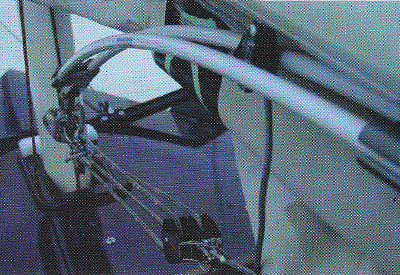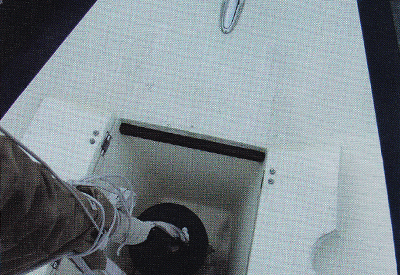New Life For An Old Boat: Etchells
By CY Staff
When Phil Sustronk, the President of “Second Skin” in Toronto, wanted to get himself a family day sailor he was torn between that goal and his ongoing love affair with his One-design Etchells.
Flexible fellow that he was, he found the best of both worlds. Rather than take his racing boat off the circuit, he enlisted the help of Etchells builder, Dirk Kneulman from Ontario Yachts, and uncovered an old second-hand unloved hull.
Together they resurrected it into a unique and simple but elegant day sailor.
The elements of the new retrofit included furling gear, self-tacking jib, a neat new boom kicker, a revised configuration for the cockpit and the addition of an engine and a bit of wood trim in the right places.
The results are astounding, even when just seen on the trailer. The blue hull stands out – a very nice touch when you’re used to seeing the white hulls of a fleet of seventy-two Etchells tacking at the start line.
Right away you notice the warm cozy safe feeling, the warm colours, and the feeling of wood that makes this boat present like an old England cruising classic. And it’s not hard to understand the charm and grace when you consider the boat’s history and the story of its famed designer, Skip Etchells.
When Yachting magazine sponsored a design competition based on the IYRU (now ISAF) specifications for the new three-man Olympic keel boat in 1965, Skip Etchells, a yacht designer and boat builder from Greenwich, Connecticut, decided to design and build a contender for the trials set for the fall of 1966 in Kiel, Germany.
The results of Skip’s effort were “Shillalah”, sailed by Skip himself. Other entries included Soling, Conqueror, Thrice, Ander and Kobold.
 Ten races were sailed. Skip and “Shillalah” won eight. In spite of this enviable showing, judges couldn’t agree and decided to try again in 1967 at Travemunde, Germany.
Ten races were sailed. Skip and “Shillalah” won eight. In spite of this enviable showing, judges couldn’t agree and decided to try again in 1967 at Travemunde, Germany.
The judges there inexplicably chose the Soling as the Olympic boat.
Even so, by the time Skip returned to Connecticut in the fall of 1967, “Shillalah’s” performance had attracted a following. An initial order of twelve boats was placed with Skip’s yard, Old Greenwich Boat Company.
Determined to build to strict one¬ design standards to ensure fairness of the boat and to test the ability of the skippers and crews, Etchells applied to the IYRU, which formally recognized it as an international class, adopting the class rules, measurement form and rules pertaining to one-design control.
Fast forward to Sustronk’s new boat. The new improved version is clearly not designed for racing; it has been reborn as a quality, crew- and family-friendly day sailor.
The cockpit layout is clean and neat and includes storage compartments and re-engineered spinnaker launchers to serve as wine bottle holders. The forward portion of the cockpit is enclosed with a zippered tan cloth cover, providing a bigger and more efficient storage area than that found in the traditional Etchells. Wooden seats grace both sides of the cockpit and allow easy and comfortable seating for all crew. One could easily see four to six people comfortably sailing in this layout. Control lines, as with its racing cousin, are lead back to a centre consul. That makes for easy access to controls for the entire crew.
The self-tacker is a neat feature borrowed from the Soling, quite frankly a perfect solution for the Etchells day sailor. It’s easy to tack and makes for ease of handling even with inexperienced crew. It is complemented by the jib furling system to allow quick and painless sail reduction when necessary.
Fitting the engine aft behind the traveler and rudder post was accomplished by creating a boxed-in through-hull configuration that allows the engine to be raised and lowered effortlessly. A deck hatch covers the engine when sailing.
One feature I loved was the boom kicker, an idea provided by Quantum’s Greg Bratkiw. Simple and elegant, it fits under the boom, supporting it efficiently but leaving tons of room to move under it.
The sails too are a nice touch: Quantum-made with the traditional Classic Egyptian cotton look. The fabric is a 7 oz polyester dyed to provide the classic colour. The tapes, batten pockets and reinforcing are all made from the same fabric. Everything was custom here. The fabric itself has a softer finish to provide better durability and handling. The look is much easier on the eyes and provides the boat with a definite classic flair.
 Sustronk wanted a boat that incorporated everything he loved about his Etchell, but wanted a family-friendly day sailor too.
Sustronk wanted a boat that incorporated everything he loved about his Etchell, but wanted a family-friendly day sailor too.
With the help of Dirk Kneulman he handily accomplished his goal.
And, in the process, he gave new life to an old boat.
For more information on the Etchells and this specific project, contact Ontario Yachts at 905 639 8382. For more information on the sails, contact Quantum Sails in Toronto 416 503 1931.
Originally published in Canadian Yachting’s April 2006 issue.
Photo Captions
Photo 1 – Recently refitted Etchell starts new life as a simple, elegant day sailor,
Photo 2 – The boom kicker is an increasingly popular replacement for the topping lift, found on many racing and cruising boats in Canada.
Photo 3 – Furling gear on the refitted Etchell just enhances the boat’s “ease of use”.























